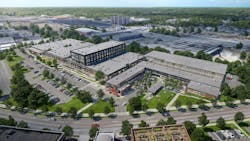Coca-Cola packaging warehouse transformed into mixed-use complex
By Peter Fabris, Contributing Editor
An adaptive reuse project in Atlanta turned an obsolete Coca-Cola packaging warehouse into a vibrant mixed-use retail/restaurant/office complex. The 250,000-sf structure is located along a now defunct railroad line that forms the footprint for the city’s multi-phase Beltline pedestrian/bike path that will eventually loop around the city.
“With the Beltline Spur Trail planned for the abandoned railroad and other neighborhood transitions, the design goal became how to modernize the existing building while preserving its industrial history,” says Victoria Walsh, AIA, LEED AP, Architect, Perkins&Will. “Our big move was cutting up the warehouse into three separate parts. New promenades through the building allowed natural light, ventilation, and direct entry to the office and retail spaces.”
Westside Paper Mixed-Use Redevelopment
Contemporary elements were incorporated into the design to harmonize with the emerging Westside aesthetic. Echelon Masonry's Mondrian Stone provided a sleek, modern canvas for the darker steel elements and weathered brick walls.
The design preserved the steel armature framework overhead. Steel and glass clerestory windows were preserved and painted a dark bronze color that created a backdrop for the original masonry walls. “The light/dark contrast between the Mondrian Stone and painted bronze steel allowed for that clear delineation between old and new,” Walsh says.
The 15-acre location has already been leased by multiple vendors, with only a few spaces remaining.
“The neighborhood has rapidly changed with so much residential development moving in,” Walsh says. “Another adaptive reuse project King Plow—a former plow factory converted into a popular arts center, is just across the street.”
On the Building Team:
Owner and/or developer: FCP (Federal Capital Partners)
Design architect: Perkins&Will
Architect of record: Perkins&Will
MEP engineer: Barrett Woodyard
Structural engineer: Shear Structural
General contractor/construction manager: Gay Construction


